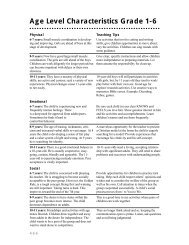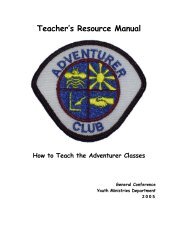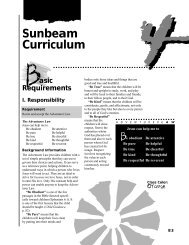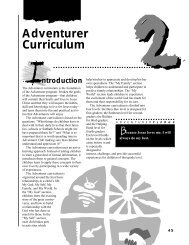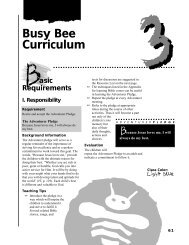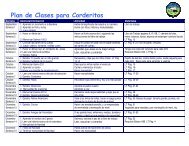Adventurer Awards - KFW Adventurers
Adventurer Awards - KFW Adventurers
Adventurer Awards - KFW Adventurers
Create successful ePaper yourself
Turn your PDF publications into a flip-book with our unique Google optimized e-Paper software.
A D V E N T U R E R M A N U A L<br />
○ ○ ○ ○ ○ ○ ○ ○ ○ ○ ○ ○ ○ ○ ○ ○ ○ ○ ○ ○ ○ ○ ○ ○ ○ ○ ○<br />
Grade 1<br />
Updated in 1996.<br />
Swimmer I<br />
Complete the Red Cross Swim Level I—<br />
Water Exploration or the following:<br />
1. Learn seven safety rules for swimmers.<br />
2. Fully submerge face for three seconds.<br />
3. Experience buoyancy. Bounce up and<br />
down in chest-deep water, maintaining<br />
an upright position for ten bounces.<br />
4. Demonstrate support float on front and<br />
back.<br />
5. Demonstrate bubble-blowing.<br />
6. Enter and exit water independently<br />
using ladder, ramp, steps, or side of<br />
pool.<br />
7. Walk five yards in chest-deep water<br />
maintaining balance, or move five<br />
yards along the side of the pool<br />
maintaining contact with the wall.<br />
8. Demonstrate kicking on front and<br />
back.<br />
9. Walk five yards in chest-deep water<br />
using alternating arm strokes.<br />
10. Discuss the importance of following<br />
rules.<br />
11. Discuss the role of safety personnel<br />
and EMS.<br />
12. Demonstrate reaching assists without<br />
equipment.<br />
13. Demonstrate how to relieve a cramp.<br />
14. Demonstrate wearing a life jacket on<br />
desk and enter shallow water.<br />
Helps<br />
The goal is to introduce children to water<br />
and to help them get over any fear they<br />
may have.<br />
1. Do not swim without an adult<br />
present. Do not run near water. Do<br />
not dunk another person. Do not<br />
push or shove another person. Do<br />
not play in water over your head<br />
until you can swim. Do not depend<br />
on flotation devices; learn to swim.<br />
Do not jump into water without<br />
knowing it is safe.<br />
2. Along with the children, make a<br />
game of ducking and holding your<br />
breath. You may also want to have<br />
them practice holding their breath<br />
out of the water first.<br />
3. Teach the children to jump safely<br />
into water after the area is clear of<br />
rocks, other swimmers, etc.<br />
4. Play a water game in which the<br />
children will get some water<br />
splashed on them without scaring<br />
them.<br />
5. Show the children how to hold the<br />
edge of the pool or a paddle board<br />
while developing a proper and<br />
strong kick.<br />
6. Show them how to push off, hold<br />
their breath, and kick under water.<br />
7. Teach children safety rules for<br />
where and when it is safe to swim:<br />
never without an adult present; not<br />
when it is stormy; never jump or<br />
dive into water without checking<br />
out the area first; only in clean<br />
pools, lakes, and rivers where it is<br />
safe to swim and where you have<br />
permission to swim, etc.<br />
8. Text resource: the American Red<br />
Cross Water Safety Instructor’s<br />
Manual or contact the Canadian<br />
Red Cross and the Life-Saving<br />
Society for equivalent requirements.<br />
292







